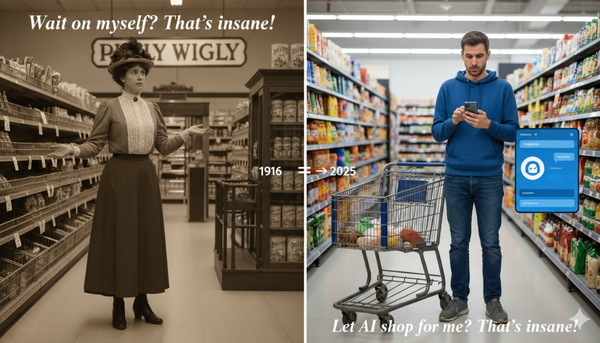Amazon's Rufus AI Patent, Explained
Amazon's launch of Rufus AI in early 2024 generated plenty of buzz about conversational shopping, but a recently uncovered patent reveals something far more significant: a fundamental shift in how products will be discovered and purchased on Amazon

Amazon's launch of Rufus AI in early 2024 generated plenty of buzz about conversational shopping, but a recently uncovered patent reveals something far more significant: a fundamental shift in how products will be discovered and purchased on Amazon. The patent, analyzed in detail by Amazon Strategist Danny McMillan, AI Developer Andrew Bell, and Growth Strategist Oana Padurariu, shows that Rufus isn't just a chatbot – it's a complete reimagining of product search and discovery.
My 10-min video recap also covers all the points from this article!
Beyond Keywords: The Three Pillars of Rufus
The patent reveals three core technologies driving Rufus: the Semantic Similarity Model (330), ClickTraining Data (340), and Visual Label Tagging (VLT). Together, these systems represent a dramatic departure from Amazon's traditional A9 algorithm.
While A9 relied heavily on keyword matching and sales velocity, Rufus's Semantic Similarity Model understands context and meaning. When a customer asks, "How do you take off gel nails?", Rufus doesn't just match keywords. It understands that "pure acetone" is a solution and creates semantic bridges to relevant products. This means brands need to think beyond keyword optimization to what the patent calls "Noun Phrase Optimization" (NPO).
ClickTraining Data continuously learns from user behavior, particularly which products customers click on after specific queries. This creates a feedback loop that helps Rufus understand which products truly solve customer problems. Early testing shows that Rufus's recommendations vary significantly between users based on their shopping patterns and price preferences.
The Personalization Promise
Recent analysis suggests that Rufus may deliver the most meaningful personalization yet seen in retail search. I covered an experiment in a recent Forbes post about Rufus showing that recommendations vary significantly based on users' historical purchase behavior and typical price points. This is particularly evident in high-consideration categories like pet food, where price sensitivity and emotional investment in decisions run high.
Interestingly, traditional Amazon ranking signals like "Amazon's Choice" badges don't seem to carry the same weight in Rufus's recommendations as they do in standard search results. This suggests Amazon is developing a different framework for AI-driven product discovery that relies more heavily on personal shopping history and semantic understanding than conventional ranking factors.
What This Means for Brands
The implications for brands are significant. Success in the Rufus era requires several strategic shifts:
- Natural Language Optimization: Instead of keyword stuffing, brands need to create product content that flows naturally and addresses real customer needs. For example, rather than just "desk lamp," use "adjustable brass desk lamp with eye-comfort lighting for bedside reading."
- Visual Content Evolution: Through Visual Label Tagging, Rufus processes product images alongside text. Brands need to think about their product photography and infographics as part of their semantic strategy, not just as attractive photos.
- Question & Answer Focus: The patent reveals that Rufus heavily weights Q&A content to build semantic connections between problems and products. Brands should focus on creating comprehensive, natural Q&A sections that address real customer needs.
The Advertising Equation
The relationship between paid advertising and organic visibility may also evolve. While advertising will always play a role in product discovery, Rufus's semantic understanding and click training data suggest that genuine problem-solution relationships will become increasingly important. Ads might get you seen, but they won't help if customers don't find your product genuinely relevant to their needs.
The advertising implications of Rufus became clearer in November 2024, when Amazon quietly updated its API documentation to indicate that sponsored ads would potentially be incorporated into Rufus conversations.
“To help customers discover more products in Amazon’s generative AI-powered shopping assistant, referred to as Rufus, your ads may appear in Rufus-related placements,” the release notes said. “Rufus may generate accompanying text based on the context of the conversation.”
While advertisers won't be able to track Rufus-specific performance metrics, this integration signals a significant shift in retail media. The traditional model of bidding on keywords may evolve as AI assistants like Rufus generate contextual ad placements based on conversational flow rather than explicit search terms.
Looking Ahead
While it's too early to completely rewrite the Amazon playbook, one thing is clear: the era of keyword stuffing and manipulative listing practices is ending. Rufus represents Amazon's effort to make product discovery more human and less algorithmic – ironically, by using advanced AI to do it.
For brands, success will increasingly depend on creating authentic, comprehensive product content that clearly communicates what your product is, what problems it solves, and how it fits into customers' lives. The goal isn't just to be found by Rufus, but to be understood by it.
The winners in this new era will be brands that embrace semantic optimization while maintaining the flexibility to adapt as AI shopping assistants continue to evolve. The future of e-commerce discovery is conversational, contextual, and customer-centric. Are you ready for it?





